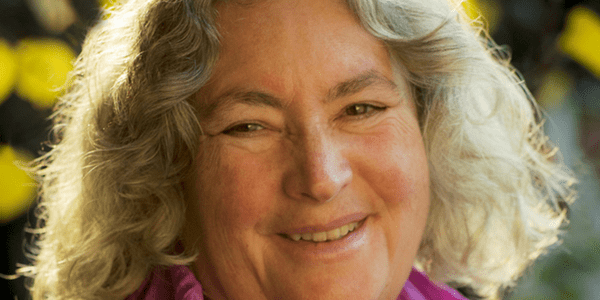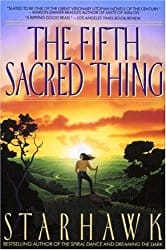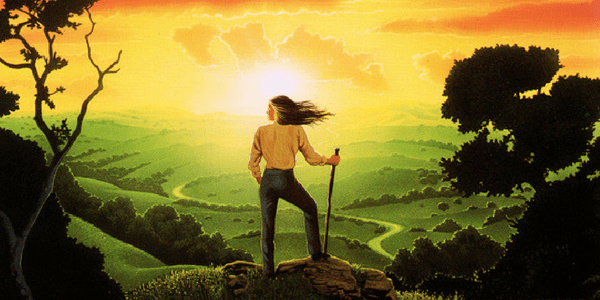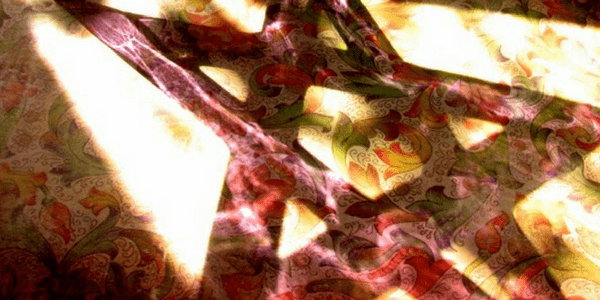
 The Fifth Sacred Thing by Starhawk was published in 1993 but in the more than two decades since the book has hit the shelves, it has become strangely apt for the times we live in.1 This novel eerily mirrors much of the political upheavals and changes that are happening in the world today but also tells us a lot about the power that is in us to resist these changes that will harm marginalized people.
The Fifth Sacred Thing by Starhawk was published in 1993 but in the more than two decades since the book has hit the shelves, it has become strangely apt for the times we live in.1 This novel eerily mirrors much of the political upheavals and changes that are happening in the world today but also tells us a lot about the power that is in us to resist these changes that will harm marginalized people.
I did not read this book when it was first released so this is my first time experiencing this text. I am reading this book as a Black woman who lives in the America of 2017, and although the initial set up had me rolling my eyes at the now oft used apocalyptic tropes, by the end of the book I was reading wide eyed and wondering how many short steps away from this future we really are.
Religious tensions
The Fifth Sacred Thing is the story of Bird, Maya, and Madrone, three people from two generations of witches that live in a transformed San Francisco after a religious and violent totalitarian government has taken hold of the country. The type of religious group is never really specified but the subtext is that it was a sort of conservative Christian practice. The book touches on a second coming of Jesus but mostly the religious aspects of this cult are about creating groups that can be oppressed. Committing an act that causes you to “lose your soul” just means that you become part of class of people that can be used by those who have not. This part was vague but subtext, that this was meant to be an extreme variation of the Christian right.
As an aside, Starhawk is obviously making some very heavy handed references to Christianity as practiced here, in the States. What’s most interesting about it is that the “religion” is not actually practiced and the people who were true believers were executed in the course of the history. She is not creating a space that says Abraham religious beliefs are bad, she is pointing out in this text that they often are used in today’s world as a tool of oppression and not of worship, which I think is a valid critique.
Outside of San Francisco, the country is a wreck with scant resources, besieged by death and war. In their community, however, their belief in the Four Sacred Things — earth, wind, air, and fire — and the idea that no one can own these things have helped shaped a small reality of relative safety and abundance. This idea may be part of Starhawk’s personal philosophy and, considering she wrote this book, likely is, but more than that it speaks to the sort of return to nature brand of spirituality that is prevalent in the US.
This is all shattered when, having run out of resources, the people from the Southlands move North to attack the community. In order to survive the siege, they must rely on their own unique power, that of spirit, in order to resist them.

Institutionalized oppression
The similarities between the book and our current world were oddly relevant. Ostensibly, it’s easy to see the ways that rampant abuse of the earth, long term inequality, and unchecked racism will lead to destruction. These are the things that Starhawk clearly meant to be central themes in her novel and we see them playing out in the real world today. Issues of police brutality against black bodies, the recent attacks on the Environmental Protection Agency by the American government, and the lack of accessible employment for many people. The list goes on and on but that wasn’t what made me stop and consider this work more deeply.
Two or three times throughout the text the characters mention that water is rationed or clinics are destroyed because the government believes that giving away things for free will lead to abuse by moochers who “just don’t want to work” (in a world with very few jobs).
There’s a scene when they talk about how after the war (that has led to the current conditions), people were made to register their races which was used to enforce hard line segregation.
There’s another scene where someone who calls themselves an ally goes on a tirade about lazy people (of colour) turning down the job she pays slave wages for.
These small, sometimes even one-off moments, are what makes this book so relevant for our times. Not everyone is struggling to find water in our world but we’re all on high alert about Muslim registries, losing access to health care and the microaggressions of people who claim to want to help. The magick too, was oddly familiar.

Living magick
This is a novel, so the abilities found in many of the characters has been taken to extremes that fiction allows, and lets them to do many things that we cannot. For example, Madrone has healing abilities that, with some work, can dissect a virus within herself, and while in a trance state, she can create cures that can be used on others. Obviously, this is not something we can do. Other depictions of magick in the book are much more like our realities, such as when Bird casts a spell to influence his relocation to another prison camp.
Even though these two examples of magick in the book are at complete opposite ends of the spectrum when it comes to realism, because of the way Starhawk writes them, they are both based in the reality of magick, which is the work of ritual and intent. There are no wands waved or wishes granted in puffs of smoke. Just like in real life, the magick is work and the result is a fruit of the castors’ efforts.
The magick in this book is central to the plot but it is a living type of magick, which should come as no surprise, as Starhawk is most known for her spiritual works.
This is an extremely hopeful book. The world the characters are in is dying, but the Northern group is fighting to bring it back and this brings hope to the people who live in the South. Stories of their work and magick give people who live with nothing an idea of what they could be which is in and of itself a powerful tool in reviving the world.
One of the greatest things about The Fifth Sacred Thing is that it frames magick as both something that you were born with and a talent that you could cultivate. It created a world where there were all types of magick, all kinds of powers, and encouraged people to find their own ways to bring that into the world. Ultimately, magick is what saved everyone, but not as it would happen in many fiction novels.
There’s no grand burst of power here. Instead the magick gave a way for the people to strengthen themselves and resist to their oppressors. In some cases this was the ability to heal wounds but in many cases it was just a way to feel connected to each other, to ground and endure the changes in the world around them.
This is the largest take away from this book, for me. Many of the themes, environmentalism, inequality, and racism, were quite heavy handed but the idea that our own spirit and belief can help carry us, that we can call for and channel our own power is an impactful one.
In The Fifth Sacred Thing, Starhawk created a future that she likely believed was a possibility if we continued down the same road. There are some things that are unlikely to pass, such as the loss of all technological knowledge (in San Francisco, really?) but it’s close enough to raise a few eyebrows. Instead of presenting a world that needed to be saved by a new discovery, it showed us a future in which we can save ourselves with our own strength and abilities, if only we work to cultivate them and treat them as an important part of our lives.
Image credits: Stephan Readmond and debra
- Starhawk, The Fifth Sacred Thing (New York: Bantam Books, 1993). [↩]







